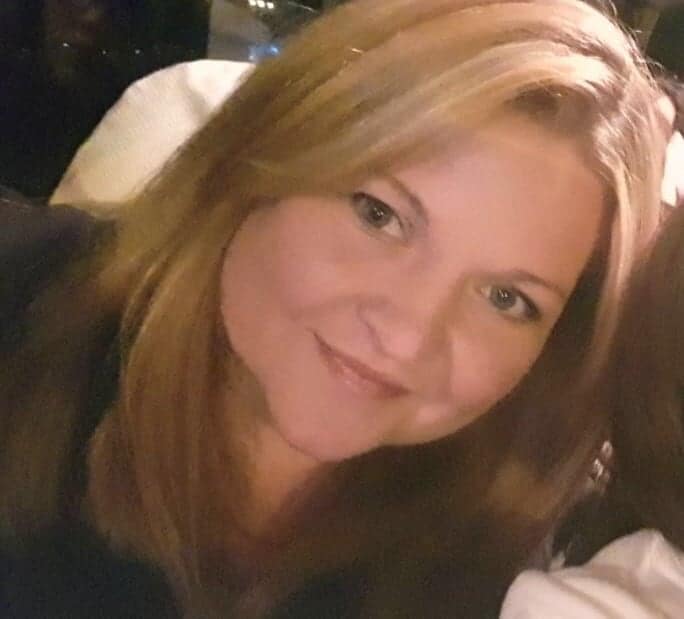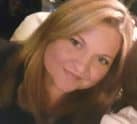
The tarot is a powerful tool that helps people understand more about their life journey. In this guide, I’m going to introduce you to the cards that make up the Major Arcana. I’ll explain what each card looks like, its role in the Fool’s Journey and how it connects with other cards in the deck, its upright and reversed meanings, and what you can learn about yourself from each card you draw.
Skip to Your Card
The Fool | The Magician | The High Priestess | The Empress | The Emperor| The Hierophant | The Lovers | The Chariot | Strength | The Hermit | The Wheel of Fortune | Justice | The Hanged Man | Death | Temperance | The Devil | The Tower | The Sun | The Moon | The Sun | Judgement | The World
What Is The Major Arcana?
The tarot is surrounded by myths, so let’s start by explaining the basics. A tarot deck is made up of 78 cards. The Major Arcana comprises 22 of these cards, which are usually numbered from 0-21. While all tarot cards have specific meanings, the Major Arcana represents important themes, influences, and messages about your life path. These cards offer meaningful explanations to help you understand the beauty of life and how deeply karma and energy can impact you. Their messages can help guide you forward.
Drawing a Major Arcana card in a reading is a sign that you should reflect on the changes going on in your life. You might even find that all the other cards in your spread relate back to the Major Arcana card and that they explain how its message has influenced or will impact you. Asking the right questions will help you get the most out of your tarot reading.
If Major Arcana cards make up the majority of the cards in front of you, it’s a sign that you’re experiencing huge changes that may have lasting effects. Pay attention to what the cards are trying to tell you: they offer a unique perspective into who you are and how your life experiences shape your future.
The placement of the cards matters, too. In a three-card spread denoting past, present, and future, the position of a Major Arcana card can reveal where you’re heading or what got you to where you are right now.
Tarot cards have two positions: upright and reversed. The way cards appear in the spread can change their meaning, especially because reversed cards don’t mean the simple opposite of upright cards. I’ve explained both interpretations in this guide, and I hope this will help you understand the complexity of the Major Arcana.
The Fool’s Journey
You can also read the Major Arcana as a story. It starts with the Fool, a naïve and inexperienced character, and follows him on his path through the cards. The Fool’s Journey sees each card as a teacher with an important lesson to impart. He learns from their accumulated wisdom and eventually reaches the World, the final card in the Major Arcana.
The Fool’s Journey also symbolizes spiritual enlightenment. The Fool is innocent and influenced by everything around him. As we move through the cards, you’ll see how each one shows increasing awareness and spirituality. They culminate with the World, a symbol of ultimate understanding and fulfillment.
This story is a beautiful depiction of the journey we all take through this world. It describes the joys, sorrows, and tests we experience as we go through life and grow into complete, fulfilled people.
Meanings of the Major Arcana Cards in Tarot
0 – The Fool
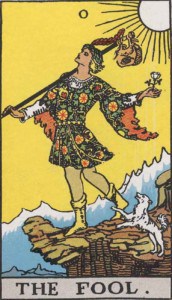
Upright: New beginnings, free-spirited, innocence, spontaneity, adventure, originality.
Reversed: Impulsive, reckless, distracted, naïve, gullible.
The Fool card is either unnumbered or assigned 0 because it doesn’t have a specific place in the tarot. It moves through the Major Arcana with us, an ever-present feature with unlimited potential. In classic decks, the Fool is shown carrying a small bag, shadowed by a dog, and heading towards the edge of a cliff.
The Fool is like a child: an innocent, blank slate whose character will be shaped by the future he is yet to encounter. He is untroubled by the future and certain that good things await him. He’s so enraptured by the beauty around him that he’s unaware that one more step could send him plummeting off a cliffside.
Generally, drawing the Fool represents the start of a new journey. His carefree spirit means you should approach your new adventure optimistically: you don’t know what’s coming, so should welcome it with open arms and be ready to jump straight in! The Fool means new ideas are waiting to be discovered and explored, and that a leap of faith now could lead to amazing opportunities later.
This card wants you to embrace the open, free, carefree parts of yourself and see the world as a wonderful, beautiful, curious place. It’s an invitation to bring more fun and freedom into your life, especially as you undertake a new adventure.
If you draw the reversed Fool, take it as a warning that you’re displaying some of his more negative traits. For example, you might be so busy living joyously in the moment that you’ve forgotten to plan for the future. It can also caution you to be aware of the people around you, as someone may be trying to take advantage of you. Finally, it can be a warning that while taking risks can be good, you’re being inconsiderate to others and that your actions may have consequences you’re not going to like.
I – The Magician
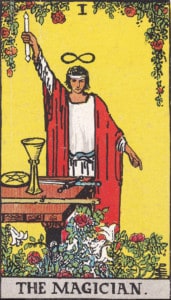
Upright: Resourcefulness, power, inspired action, manifestation, willpower.
Reversed: Unused gifts, manipulation, illusion.
The Magician is often shown with one hand pointing up towards the skies, and the other aimed down at the earth. This symbolizes his unique position as the connection between the physical world and the spiritual energies that fill the universe. He is often surrounded by the four symbols of the tarot: a cup, pentacle, wand, and sword. They represent the four elements and show that he has the power to manifest his goals.
This card represents manifestation and inspired action. The Magician shows that you have all the resources and willpower you need to make your dreams come true. When you draw this card, it means that now is the time to put your plans into action and make your intentions a reality.
Just like the Magician calls on the four elements to actualize the universe’s energy, you’ll find the greatest success when you engage all four parts of your being and set out with real intent. (If you need a recap, they are: physical (earth), mental (air), emotional (water), and spiritual (fire).) Similarly, the Magician must have absolute focus to manifest energy into something tangible. Drawing this card is a sign to remove distractions, as focusing on your goal will help you find fulfillment.
If the Magician represents power, the reversed Magician symbolizes illusion. If you draw it, it might mean you’re struggling to take action to bring your dreams to life, or that you’re unfocused and have let go of something you were working towards. It might even mean manipulation: if you’re disconnected from even one of your four elements, you might have incomplete and unfulfilling goals that could lead you to manipulate others for your own gain. You should also be careful that no-one in your life is manipulating you.
II – The High Priestess
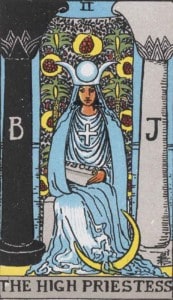
Upright: Intuition, divine femininity, subconscious understanding, sacred knowledge, inner voice.
Reversed: Disconnection from intuition, secrets, withdrawal, repression.
The High Priestess represents intuition. She’s depicted wearing a veil, which symbolizes the separation between the conscious and subconscious minds. Although she teaches us about sacred knowledge, she’s also a reminder to trust ourselves and our intuition. The moon at her feet represents subconscious knowledge, and the pillars she sits between represent the balance between logic and trust.
If the Magician’s lessons are conscious work and intentional manifestation, the High Priestess’ are hidden mysteries and subconscious knowledge. She symbolizes an awareness of things that are beyond our standard cognition and encourages us to perceive the universe’s hidden messages and energy.
Drawing this card is a sign that instead of silencing the voices in your mind or relying solely on intellect, you should start listening to what your subconscious is trying to tell you. If you hold space for your own thoughts, you’ll find your inner wisdom and discover that the answers you need already exist deep within your soul. The High Priestess is also a call to embrace divine femininity—the connection we all have to the feminine energies behind our compassion, empathy, and intuition.
If you draw this card in reverse, you may be pushing down your gut instinct about a situation or acting in a way that contradicts how you truly feel. The reversed High Priestess is a calling to listen to other people less, and trust yourself more. It might also be a sign that you need to realign your masculine and feminine energies so that you can feel more balanced moving forward. However, if the opposite is true – you’re already too involved with your inner life – the High Priestess is a reminder that you need to find balance between the world within and without.
III – The Empress
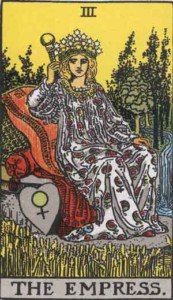
Upright: Femininity, nature, sensuality, beauty, nurture, abundance, creativity.
Reversed: Dependence, energetic blocks.
The Empress is shown as a full-figured woman surrounded by symbols from the natural world. She represents fullness and abundance, as well as a deep connection to both the physical world and the mystical realms beyond. As a physical representation of Mother Earth, she also signifies fertility and femininity.
The Empress’s energy is very motherly: her femininity is compassionate, loving, and kind. People who draw this card often find themselves drawn to taking care of other people, and gain strength from giving the care and love that others desperately need. She may also suggest pregnancy or birth, either literally or figuratively (for example, starting a new project).
Drawing this card is a reminder that while pursuing spiritual growth is admirable, appreciating the beautiful world we live in is important, too. It’s a call to experience life with all five senses, explore your creativity, and enjoy the fruits of everything you’ve worked hard for already. The Empress also reminds us to let nature nourish our bodies and replenish our minds; it’s important to get outside and take in fresh air. Acknowledging the abundance and beauty in your life will help you manifest more of the same positive energy in the future.
The reversed Empress could be a reminder to channel those feelings of love and compassion into yourself and take care of yourself instead of others for a little while. It might signify that you need to reconnect with nature and the energy that flows through the world. It may also suggest that you’re struggling with codependency and self-expression and that spending some time focused on experiencing nature and nourishing yourself will help you find your flow again.
IV – The Emperor
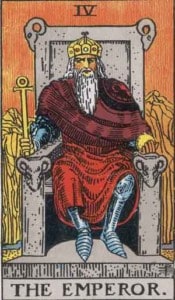
Upright: Structure, authority, fatherliness, leadership, protection.
Reversed: Control issues, domination, lack of self-discipline, rigidity, domineering.
The Emperor is often depicted as an older man with a long white beard. He is dressed protectively, and his crown and beard represent wisdom, experience, and authority. He is shown holding an orb and scepter or ankh, which signify the world, a right to rule, and life. He’s dressed in red, indicating decisiveness, action, and strength.
If the Empress is the mother of the deck and nurtures with love, the Emperor is a father who leads with strength. Drawing this card might symbolize that you’re tapped into traditionally masculine energies at the moment—you might be your family’s breadwinner or the stable rock the people around you rely on. You may also be someone who naturally commands authority, thrives within a set structure, and demonstrates the traits of a born leader. If you’re in a position of power, you use it to protect others.
Drawing the Emperor could be a signal that you need to step up and take control of a situation. When you do, remember to lead firmly but fairly—you have natural authority so don’t need to be heavy-handed with people. You’ll find success if you break down problems and resolve each issue in turn.
The reversed Emperor is a sign to let go and remember that being privileged with power and authority doesn’t mean you have all the answers. It might also signify that you’re abusing the power you have and that your leadership leaves the people around you feeling dominated, not protected. Finally, the reversed Emperor may be telling you to step into your power. If others are looking for guidance and leadership and you have the experience to help, now is the time to step up and lead.
Explore Tarot Readers on Keen Psychics
V – The Hierophant
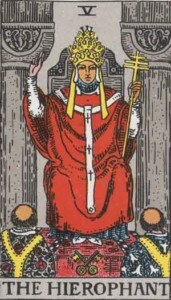
Upright: Spirituality, tradition, religious beliefs, establishment, indoctrination.
Reversed: Breaking convention, non-conformity, freedom, rebelliousness.
The Hierophant is drawn as an archetypal religious figure. He is dressed in sacramental robes and holds a triple-crossed scepter, denoting his status as a spiritual leader. The three crosses have several meanings: they can represent the conscious, subconscious, and superconscious minds; the past, present, and future; or even Christianity’s father, son, and spirit. The Hierophant is also often shown with two students kneeling at his feet.
Just like the Empress and Emperor are male and female pieces of the same idea, the Hierophant is the High Priestess’ counterpart. Also known as the High Priest, Pope, or Teacher, he represents religious knowledge, spiritual attainment, and learning within a defined and structured establishment. He symbolizes a calling to find people who share your beliefs, even if they’re not spiritual ones. The Hierophant could also signify harmful indoctrination: uncritical acceptance and blind faith.
Drawing the Hierophant is a recommendation that you get a solid education in religion and spirituality from someone trustworthy before settling on your own beliefs. It may also signify that you’re comfortable on a conventional, established path, and believe that following the rules will help you find success. Surrounding yourself with people who share your core values will help you achieve your goals. Finally, the Hierophant may be telling you that it’s time to start studying again, either professionally or by exploring your religious heritage.
The reversed Hierophant means that you’re breaking with tradition and establishing your own rules. Make sure that this stems from a place of self-knowledge and not rebelliousness: structure keeps you safe, so if you’re ready to stop conforming, let your inner wisdom guide you confidently onto your new path. The reversed Hierophant might also be a call to leave convention behind and start innovating and creating.
VI – The Lovers
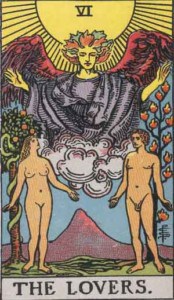
Upright: Harmony, honesty, relationships, passion, love, choices, communication.
Reversed: Disunity, imbalance, detachment, distance.
The Lovers card looks like the biblical story of Adam and Eve in the Garden of Eden. A naked man and woman represent passionate lovers, while a snake curling down an apple tree signifies temptation. Other symbols that sometimes appear include a volcano, suggesting an eruption of passion, and an angelic figure looking down on the couple.
While the Lovers often signify the sexual and passionate nature of romantic relationships, this card isn’t only about love. It also represents the vulnerability, openness, and honesty required to build a lasting connection with a partner, friend, or family member. Ultimately, the Lovers card speaks about choice: it calls you to choose who you want to be, who you want to be with, and what you stand for from a place of love and honesty.
Drawing the Lovers can mean many things. On a personal level, it’s a calling to overcome the Hierophant’s indoctrination and be honest with yourself as you define your own beliefs and values. It can symbolize conflicting ideas or personalities which, when resolved and unified, create something far more beautiful and enduring than existed before. Finally, it can show that your relationship is about more than just sex or lust—it’s a mature and gratifying connection between true soulmates.
The reversed Lovers might signify that you’re out of sync with the people around you. Opening up lines of communication and allowing yourself to be vulnerable will help you rebuild and strengthen connections with those who matter. It could be a sign that the disharmony in a relationship is irreparable or that your feelings are not mutual, and that it’s time to walk away and move on. Finally, the Lovers reversed are a call to align your actions with your values and find balance in yourself.
VII – The Chariot
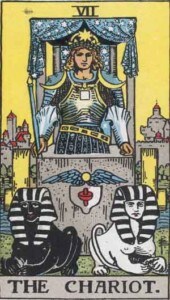
Upright: Success, ambition, action, determination, self-discipline, focus.
Reversed: Directionless, obstacles, opposition, lack of focus, aggression.
The Chariot usually depicts a warrior standing inside a chariot. His armor and crown are covered in symbols of beginnings, strength, and victory like crescent moons, laurel leaves, and stars. The chariot is fronted by sphinxes facing in opposite directions, and the warrior stands tall and holds no reins. Instead, his determination, ambition, and willpower are enough to steer the chariot where he wants to go.
If the Lovers card guided you to define your values and taught you how to make decisions in line with your beliefs, the Chariot is your call to action. It’s a reminder to be bold, determined, and self-disciplined, especially when faced with unexpected turns in the road or obstacles in your path. Your single-mindedness and determination will bring you success if you work hard and focus on the task at hand.
Drawing the chariot is a sign that now is your time. Don’t let anything (including your own passivity) stand in your way: take deliberate, focused action to make your ambitions into a reality. Just like the warrior is faced with opposing sphinxes, you’ll encounter obstacles that threaten to derail your journey. Use the conviction you learned from the Lovers and the warrior’s determination and self-discipline to push past issues, assert yourself, and claim victory.
The reversed chariot is a sign to check you’re heading in the right direction before you give everything to a single project—you may need to reassess your motivation and goals before you get started. It could also warn you of obstacles that you’ll need to overcome before you can find success, or remind you to pick up the reins and take control of a situation that feels overwhelming. Finally, it might be a sign that your determination has become aggressive. You need to relinquish control and ask for help instead of pushing forward alone.
VIII – Strength
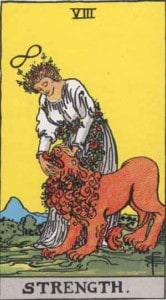
Upright: Inner strength, courage, compassion, self-control, bravery.
Reversed: Raw emotions, low energy, self-doubt, insecurity.
The classic Strength card shows a woman stroking a lion’s face. Her gentle, compassionate love has tamed the lion’s passion, ferocity, and desire, representing the incredible power of her inner strength. She is dressed in pure white and surrounded by flowers, signifying nature’s beauty. An infinity symbol near her head shows that her potential and compassion are unlimited.
If the Chariot represents sheer will, Strength shows the internal strength and endurance you need to overcome the obstacles life leaves in your way. This card teaches that self-control is even more important than our external strengths and that sometimes true strength lies in compassionate control instead of single-minded determination. Strength represents personal power and the maturity needed to harness it.
Drawing the Strength card is a sign that you’re looking for balance by learning to control some of your more negative attributes and raw emotions and harness their good sides. It’s a call to use your incredible inner powers and stay in control during tough times. It’s also a reminder to act from a place of compassion, courage, and love, instead of lashing out. It might also be a sign that you’re good in a crisis—your inner calm is enough to tame the lion, and your resilience helps you overcome trouble.
In reverse, Strength is a sign that you need to tame the unkind voices in your head and work on your confidence and self-belief. It’s also a reminder to show yourself the compassion and kindness you show others. Finally, Strength reversed may indicate that you lack inner strength and may be scared or angry about something in your life. If you’re being led by instinct or raw emotion, Strength calls you to learn to control your feelings and use them more productively.
IX – The Hermit
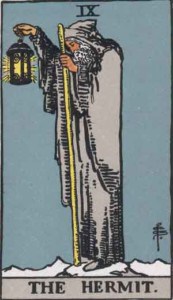
Upright: Solitude, inner guidance, introspection, seclusion.
Reversed: Isolation, withdrawal, loneliness.
The Hermit is usually portrayed as a cloaked older man standing alone on top of snow-capped mountains. He holds a lantern that’s lit by a six-pointed Seal of Solomon, representing wisdom, and a staff, symbolizing power, authority, and self-reliance. The Hermit’s immediate path is illuminated, showing that you have to keep moving forward to discover what lies ahead. The snowy peaks show that the Hermit’s solo journey has brought him to a place of accomplishment, development, and beauty.
Where Strength showed inner fortitude, the Hermit represents intentional solitude. Instead of just mastering your emotions, the Hermit calls you to retreat into your inner world and let your own wisdom guide you closer to your truest self. He has mastered his inner voice and understands how to tap into his internal wisdom. The Hermit also represents mentorship and shared knowledge.
Drawing the Hermit is a sign that it’s time to take a step away from your busy life and focus on yourself for a bit. A healthy period of introspection (like the seclusion of a spiritual retreat) can help you find clarity about what lies ahead. It might be a calling to leave materialism aside and focus on spirituality instead. The Hermit could also be telling you that you can’t plan too far ahead at the moment, but looking deep within yourself for clarity and guidance will help you find the next step on your path.
The reversed Hermit might be telling you that you’re not putting enough effort into your spiritual growth and development and that you should withdraw and create time for meditation, reflection, and introspection. Conversely, the Hermit in reverse could also be a sign that you’ve isolated yourself too much, and need to leave your inner world or risk loneliness and depression.
Browse Tarot Readers on Keen psychics
X – The Wheel of Fortune
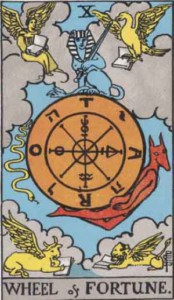
Upright: Karma, life cycles, destiny, good luck.
Reversed: Resistance, bad luck, loss of control, unwelcome changes.
The Wheel of Fortune card is laden with symbols from different cultures and religions, showing the universality of karma and change. It’s inscribed with Hebrew letters spelling out God’s name, Latin letters which could read as tora (ancient Hebrew law), taro (as in, the tarot), or rota (Latin for wheel), and the alchemical symbols for mercury, sulfur, water, and salt. It’s surrounded by a snake, sphinx, and Anubis, the Egyptian god of the dead. Four winged animals representing Zodiac signs sit in the corners, holding books.
After the Hermit’s self-reflection, contemplation, and total control, the Wheel of Fortune teaches that our destinies are fluid. Our fortunes are not constant; the wheel turns constantly and our fates can change in an instant. While this may leave you feeling like you have no control over your destiny, it also shows that as the wheel turns, bad luck will eventually be replaced with good. The Wheel is also a reminder of the karmic principle that what goes around, comes around: if you’re kind, you will be repaid with kindness.
Drawing the Wheel of Fortune may show that you need to accept that you’re not in control of everything in life and that instead of craving stability, you have to learn to go with the flow. It could also be a sign that huge, unexpected changes are on the horizon, and now is a time to trust in the universe’s plan for you. Finally, the Wheel of Fortune may signify that you’re heading into a good period, so enjoy it while it lasts.
In reverse, the Wheel of Fortune may show that a run of good luck is about to end and that harder times are coming. It could mean that you need to stop fighting change and accept that you can’t control everything that happens to you—you may be at the bottom of the wheel now, but it will keep turning and you will eventually be on top again. Finally, the reversed Wheel of Fortune may show that you’re breaking out of a bad cycle or situation, so be ready to see where this change will take you.
XI – Justice
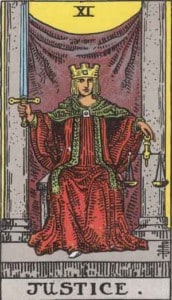
Upright: Fairness, impartiality, consequences, compassion, integrity.
Reversed: Dishonestly, unfairness, refusal to be held accountable, corruption.
Justice sits clothed in red against a purple backdrop held between two pillars. Red shows strength, purple denotes compassion, and the two pillars signify balance and structure. Her crown is decorated with a square, symbolizing power and well-ordered, logical thought. She holds a double-edged sword, showing that all actions have consequences, and scales, symbolizing that she must balance compassion and intuition with fairness and logic when making a decision.
If the Wheel of Fortune left you feeling like you have no control over events, Justice is a reminder that you are still responsible for your actions. You must do the best you can in the situations life throws at you because you will be held accountable for your choices. Justice represents fairness and truth but understands that compassion and forgiveness are important, too.
If you’re on the cusp of a big decision, drawing the Justice card is a calling to impartially weigh up all the influencing factors before making a choice. It might also be teaching you a lesson about truth: people experience the truth differently, and you should have compassion when deciding which truth is “right.” Finally, Justice may be telling you to use the lessons learned from the Hermit and Strength to ensure your decisions align with your beliefs.
Drawing the reversed Justice card is a sign that if you’ve done something you’re not proud of, you should step up and face the consequences of your actions. It’s definitely better to own up than be called out. Justice in reverse is also a reminder that your past actions are in your past, and that you can be better going forward. Lastly, it could be a sign that you’re judging yourself too harshly, and that you need to treat yourself with the compassion and understanding you try to show others.
XII – The Hanged Man
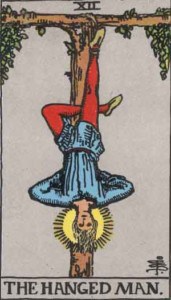
Upright: Surrender, acceptance, new perspectives.
Reversed: Blocks, stalling, indecision.
The Hanged Man is suspended by one ankle on a T-shaped frame of living wood. Despite his precarious position, he seems relaxed: a halo surrounds his head, signifying new insight, and his arms and free leg are crossed behind him. He hangs on a live tree, showing health and vitality, and his serene expression seems to show that he is hanging by choice, enjoying his chance to gain a new perspective.
If Justice reminded you to take accountability for your past actions, the Hanged Man tells you to pause and think before you do anything else. This card is a sign that you should try to find a new perspective before jumping into anything new. Pausing on your journey to assess where you’re up to and where you’re going can help you find new meaning and purpose going forward. Taking a breather can help you start up again with renewed energy.
Drawing the Hanged Man in a reading often means that you need to take a break and gain perspective and clarity before continuing on your journey. This pause may inspire you to change direction, so don’t push it off—rest is just as important as work. This card could also signify that forces outside your control are going to slam the brakes on something you’re working on, so be ready to accept this involuntary stop and surrender to the changes in your life.
The reversed Hanged Man shows that if you’ve been resting for a while, now is the time to start again with a renewed purpose and energy. It might also represent that you’re stalling before starting something new and that now’s the time for action. Finally, the Hanged Man in reverse might be telling you that you’re filling your days with busy work and resisting taking a break to focus on real issues. Keeping busy won’t help you—eventually, you’ll have to stop. Make time for a break instead of pushing forward until you crash.
XIII – Death
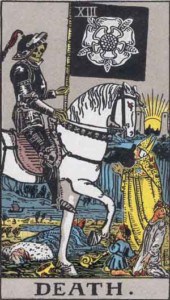
Upright: Endings, transformations, transitions.
Reversed: Resistance to change, lack of acceptance.
Death is portrayed as a skeleton dressed in armor, suggesting invincibility and inevitability. He sits atop a white horse, representing purity and strength. He carries a five-petaled white flower on a black flag, symbolizing purification, immortality, and change. A dead man lies beneath the horse, while a bishop, woman, and child plead for their lives. Death spares no-one, but his flower and horse show that there is beauty in all transformations, even death.
If the Hanged Man represents a period of reflection to help guide your future path, Death is the end of the period that got you there. An important chapter in your story is coming to a close, opening the door to something new. Despite its ubiquity, Death still surprises us—the changes coming your way may shock you. However difficult and painful it may be, you have to leave the past behind and be ready to truly embrace whatever comes next.
Drawing the Death card doesn’t mean that death and misfortune are on their way. Instead, it symbolizes a period of transition. While the endings you have to deal with may cause pain, they will bring you new, transformative experiences. The Death card can also be a calling to break unhealthy cycles that are harming your growth. Cleaning out your emotional baggage and letting go of unhealthy memories will help you move forward. Finally, the Death card may signify actual death. As hard as it may be, try to see the loss of a loved one as a transition from our world to the next realm and a celebration of life.
The reversed Death card shows that you’re on the precipice of change, but are resisting it. It’s a calling to accept change and go with the flow or risk being drowned by the current. It can also be a reminder to let go of unhealthy parts of your past and open yourself up to new experiences. Finally, it might indicate that even though you’re ready for change and release from a situation you’re unhappy with, now is not your time.
XIV – Temperance
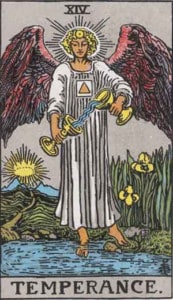
Upright: Moderation, patience, balance, purpose.
Reversed: Imbalance, excess, misalignment, rushing.
Temperance looks like an androgynous angel with large wings, dressed in a loose white gown, symbolizing purity. The gown is decorated with the Hebrew letters yud, hay, vav, and hay, which spell out a name for god and represent divinity, and a triangle inside a square, showing that humanity is bound by the laws of nature and the universe. Temperance pours water between two cups, showing that life is fluid and made up of blended elements. She is balanced with one foot on a rock and one in water, symbolizing an equilibrium between being grounded and flowing with the universe’s energies.
If Death represents significant change and transformations, Temperance is an invitation to approach your new phase with patience and moderation. It calls you to find balance so that the events in your life can influence you without upsetting you. Temperance is a sign of control: after a period of upheaval, now is a time for quiet purpose and moderation.
Drawing the Temperance card in a reading is a calling to approach your life with patience and calm. Staying grounded will allow you to approach new challenges without becoming overwhelmed. It’s also an invitation to accept different influences and blend them together to create something new and unique. Finally, Temperance symbolizes the long game. You have a plan, but there’s no need to rush—take it slow and stay balanced.
If you draw Temperance in reverse, it’s a calling to cut out any excesses or extremes in your and restore balance; ground yourself so that you can accept life’s flow and stop resisting change. If you’re lacking purpose, Temperance might be telling you to make a plan and stick with it. Finally, if you’ve been experiencing stress or sadness, Temperance could be telling you that now is your time for healing and introspection. Find the source of your imbalance and realign your heart, mind, and spirit so that you can heal.
Browse Tarot Readers on Keen psychics
XV – The Devil
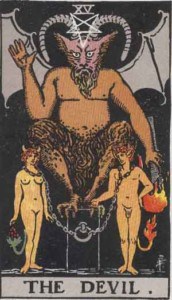
Upright: Addiction, obsession, excess, dependence.
Reversed: Breaking cycles, freedom, taking back control.
The Devil is drawn as Baphomet, a medieval half-man half-goat deity with dark bat wings. He holds a fiery torch and has large, curved horns with a pentagram drawn between them. A man and woman are chained near his feet. They wear loose chains around their necks, showing that they’re choosing to stay in bad company, and have grown horns and a tail, symbolizing that the longer they remain with the devil, the closer they resemble him.
If Temperance called you to find balance, the Devil is a stark reminder of what happens when you don’t. A little indulgence is good for the soul, but overdo it, and you risk dependence on or even addiction to your vice. It also shows that you may feel trapped, but external forces aren’t to blame—you’re being held in place by your own limits.
Drawing the Devil is always a sign that something needs to change. You might be giving in to your raw desires or animal instincts, leading you to treat yourself (or others) in a cruel way or overindulge on things that are only healthy when consumed in a moderate, balanced way. You might be struggling to overcome dark thoughts or negative energies, or dealing with toxic relationships or addiction issues. The Devil is a reminder that you can take back control: acknowledge that you have a problem, and seek help learning to control it.
The reversed Devil is a sign that you’re finally ready to leave a harmful situation. It takes strength and commitment to break the cycles that keep you trapped in unhealthy habits, but the reversed Devil shows that you’ve reached a place of strength and control and are ready to move forward into a healthier and more balanced future. The reversed Devil might also symbolize that you’ve been torturing yourself over something in your past and that now is the time to release yourself and let it go.
XVI – The Tower
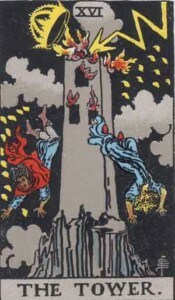
Upright: Chaos, shock, upheaval, regrowth.
Reversed: Fear of change, spiritual awakening, questioning.
The Tower card shows a spire-like tower on top of a craggy mountain top. While the tower itself is strong, it stands on a weak foundation. A lightning bolt strikes the golden dome topping the tower, representing a flash of insight destroying years of labor. Flames pour from the windows and roof, and everyone—royalty and servants alike—jump from the flames to try and save themselves.
If the Devil helped you take control over your obsessions and vices, the Tower reminds you that nothing is stable. The foundations of your beliefs may be weak, and a single event can bring everything you’ve worked for crashing down around you. Prepare for the worst: Tower events upend things that seemed solid but were built on shaky ground. Investments into poorly-managed plans may bring financial ruin, and relationships built on dishonesty may end in infidelity and even divorce. A loved one’s death may be a painful reminder that life is the most unstable and insecure thing of all.
Drawing the Tower in a reading shows that a shocking event is coming. It will disrupt everything you thought you believed and challenge you to stay true to your beliefs and values. Jumping from the flames isn’t an act of weakness—the Tower will fall, and jumping is the only way to save yourself so you can start again. The sooner you accept that everything is different now, the sooner you’ll be able to repair your foundations and start rebuilding on more solid ground.
Contrasting with the huge external upheavals of the Tower, the reversed Tower is a sign that a lightning flash of insight will strike from within, upsetting your value system and breaking down your beliefs. It might also mean that you know you need to enter a period of change and transformation, but you’re scared of creating pain and upheaval. Accept that change is needed and that ultimately, it will help you grow stronger.
XVII – The Star
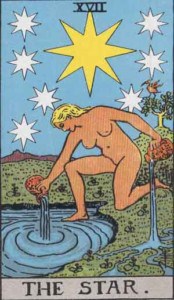
Upright: Healing, hope, nurture, connection.
Reversed: Disconnection, lack of faith, negative energy.
The Star card shows a naked woman kneeling over a pool of water. She pours water into the pool, showing continuance and connection, and onto dry land, showing nourishment and healing. Her nudity symbolizes her purity and vulnerability, and the placement of her feet shows that she is both securely grounded and immersed in the flow of energy around her. A large star is surrounded by seven smaller stars, representing the woman’s inner essence and her seven chakras.
If the Tower represents a period of disruption and destruction, the Star is a symbol of self-assurance and healing. The challenges you’ve faced have helped you overcome your limitations and find your truest self. After so much upheaval, the Star represents a time for healing and reconnection with yourself and the people around you. It symbolizes finding tranquility and restoring peace and balance after the storm has passed.
If you draw the Star in a reading, it’s a sign that your challenges are almost over, and you’re about to enter a period of calmness and happiness. Take time to get acquainted with this pure and enlightened version of yourself, and give yourself space to heal from past trauma. The Star may also call you to use your experiences to help others, bringing fresh purpose and perspective into your life. Focus on your emotional, spiritual, and mental wellbeing: if your inner self is well-nurtured, you’ll be able to give to others and help change their lives, too.
When the reversed Star appears in a reading, it’s often a sign that you’re disconnected from your truest self, and that you’ve lost faith in the universe’s energy. If you’ve just been through a Tower event, it’s easy to see why you’d lose faith, but take time to reconnect with the energy and beauty that flows around you. Now is the time for simple self-care practices and gentle self-nurturing.
XVIII – The Moon
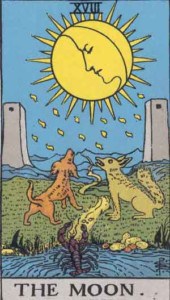
Upright: Anxiety, illusions, subconscious thoughts, balance.
Reversed: Lack of understanding, fear.
The Moon shows a crayfish leaving a pool on a winding path. The water represents the fluidity of our subconscious, and the small creature shows how vulnerable we are as our subconscious mind starts to fully develop. A wolf and dog stand on each side of the path, flanked by two towers, symbolizing the tame and wild, or the conscious and subconscious. A sleeping face in the moon represents our subliminal, sleepy thoughts.
If the Star brought you to a time of healing and repair, the Moon is an invitation to dig even deeper and spend some time working through issues that are buried far below the surface. If you’ve repressed painful or sad memories and experiences, now is the time to unearth them and fully process your past. After all, repressed memories dwell in our subconscious, and impact how our minds work and energies flow. Dealing with past trauma is the only way to find true healing and clarity.
Drawing the Moon in a tarot reading indicates that your subconscious may be harboring memories and emotions that are affecting your potential for happiness and peace. It may also show that you’re entering a period of illusion and should be wary of making big decisions without all the information you need and a clear head. The Moon may also represent anxieties that are preventing you from reaching your full potential.
The reversed Moon card is a sign that you’re trying to further repress or bury thoughts and feelings because you’re scared of dealing with them. It’s a calling to bring them out into the open and free yourself from years of repression, anxiety, and sadness: you deserve better. Finally, it may be telling you to start listening to your subconscious and trust your inner voice and intuition—trust that you are your own best guide.
XIX – The Sun
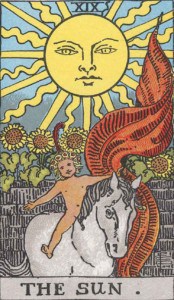
Upright: Confidence, happiness, success, vitality, warmth.
Reversed: Over-enthusiastic, lack of clarity or direction.
This card is rare in that it has no negative connotations at all. It shows a bright yellow sun beaming down on a smiling child sitting on a white horse. The child’s nudity shows innocence and openness, while their flowered crown and white horse symbolize purity and beauty. Four tall sunflowers show that the Sun is warm and nurturing, and show the balance between the four elements. The draping red flag represents energy and renewal.
If the Moon called you to exhume your hidden memories and work through any lingering sadness in your subconscious, the Sun symbolizes the confidence and happiness you experience when you are totally aligned with your truest, most authentic self. You exude warmth and vitality, and your positive nature will help you succeed in everything you try. You may find that other people are pulled into your nurturing light and that you have enough energy to help those around you be their best selves, too.
If you draw the Sun in a reading, you can rest assured that strength and warmth will guide your actions, bringing you happiness and fulfillment. Your deeply-rooted sense of self will allow you to approach new challenges with confidence. Bring your enthusiasm and vitality to everything you do, and you are guaranteed to find happy outcomes at the end.
The reversed Sun is a calling to keep your ego and enthusiasm in check—enjoy this happy, self-assured, confident period, but remember to treat those around you with continued kindness and compassion. It could also symbolize that you’re struggling to see the bright side or a clear path ahead. Trust yourself to find a way through, and put work into achieving your goals: sunflowers need the sun to help them thrive!
Browse Tarot Readers on Keen psychics
XX – Judgement
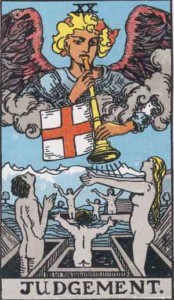
Upright: Clarity, forgiveness, rebirth, inner peace.
Reversed: Self-reflection, overly critical.
The Judgement card shows gray-skinned men, women, and children rising from their graves. They are naked with outstretched arms, seemingly surrendering to the inevitability of judgement. The coffins seem to be floating on water, symbolizing that energy remains fluid and flowing in the universe, even after death. Above them, a red-winged angel blows a trumpet, calling the people below to their final judgement.
If the Sun’s warmth and positivity helped you fully connect with your inner light and find true happiness, Judgement calls you to listen and respond when you hear a trumpet summoning you to your higher purpose. Unlike Justice, which asked you to accept accountability for your past actions, Judgement asks you to accept yourself—mind, body, heart, and spirit. Placed so close to the end of the Fool’s Journey, the Judgement card reminds you that you are a product of everything you’ve experienced. Look at what you’ve survived, and judge yourself kindly.
In the upright position, Judgement reminds you to use your full consciousness when facing new challenges or making new decisions. Use everything you’ve learned to approach upcoming events with compassion, logic, intuition, and strength. It can also show that a time of reckoning is coming. Don’t hide from it: facing it will help you move into the future fully absolved of any guilt or regrets that still linger.
Drawing the Judgement card in reverse is a reminder that judgement must sometimes come from within. Create space and time for some serious self-reflection and introspection, and identify any lingering hang-ups you need to work through. It’s also a call to stop fearing others’ judgement: if you’re happy with your decisions and confident in who you are, live your most authentic life without worrying about what anyone else thinks. Finally, the reversed Judgement card could be a sign that you’re being too hard on yourself or those around you. Accept people (including yourself) where they are—it’s not your place to judge, and support is always more helpful than criticism.
XXI – The World
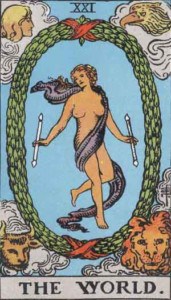
Upright: Completion, accomplishment, wholeness, harmony.
Reversed: Closure, seeking fulfilment.
The World card shows a naked woman wrapped in a purple cloth. She’s dancing, and her posture shows that while she’s happy to look into her past, she’s also moving forward into her future. She holds two wands, showing that she’s manifested her plans. She stands in a round laurel wreath, symbolizing completion and wholeness. The faces of a cherub, eagle, lion, and bull sit in each of the four corners, representing the four fixed zodiac signs, the four suits of the tarot, and the four seasons.
If Judgement called you to realize your higher purpose and judge yourself generously, the World represents the completion of your journey. You’ve reached a point in your journey where you can look back at everything you’ve accomplished with a deep sense of happiness and fulfillment. Enjoy this period of wholeness, and use it to explore the unity between your physical life and the energetic and karmic forces at work beyond your immediate vision.
Drawing the World card in a reading means that you’re reaching the end of a period of your life and that you should be proud of your success and achievements so far. If you’re not quite finished with a project you’re working on, the World is your calling to bring the final pieces together. Finally, the World symbolizes harmony and unity. If you’ve experienced any discord with the people around you, now is the time to mend bridges and find balance in your relationships.
Like the Sun, the World card doesn’t have any negative meanings. Drawing the reversed World is usually a symbol that you’re seeking closure or personal fulfilment, but that it’s still a little out of your reach. Spend time working through the issues that are preventing you from finding that sense of personal completion. Once you do, you’ll be able to enjoy everything you’ve worked so hard for with a whole spirit and satisfied heart.
Bottom Line
The cards in the Major Arcana represent important themes and events that most of us will experience in our lifetimes. The upright and reversed cards have different meanings which are equally important when it comes to understanding what the cards are telling you. They also tell the story of the Fool’s Journey, which explores and explains the journey we all go on in our search to become fulfilled and complete beings.
If you’re ready to try a tarot reading for yourself, check out our list of the top sites for online tarot readings.
